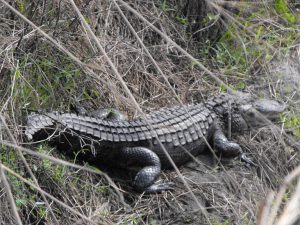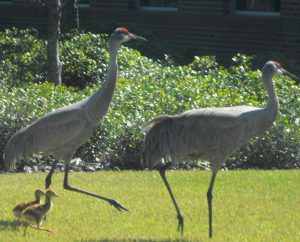We had a recent employee, Bill Dermott, who upon his departure gave me a list of all the birds he had observed at our research center over the last 6 months or so. We’re talking about 80 different kinds of birds. This list consisted of the species and variety of each specimen he found. A great deal of work and dedication was put into this list and to make it complete, I went online and search for each bird in order to include a photo to his list. Pulled it all together into a 11″ x 17″ color poster and set them out for our staff. People are loving this little poster, which I have now printed in a larger size to frame for our break rooms. The next step will be a flip book to have on display in the lobby.
Okay, we’re an agricultural research center and most of our faculty and staff are focused on tomatoes, strawberries, and other ag commodities. However, when you’re on a piece of property that is nearly 500 acres, you’re going to see a lot wild life. I personally have only seen a small example of our wild life population. I have gotten photos of the random hawk, our mated pair of sandhill cranes, and yes, the alligator in our pond. Yet, seeing the number of birds in our immediate area on paper certainly made me realize how lucky we are to work at center located in a very rural area of southern Hillsborough County.

 The variety of feather and fowl is pretty impressive. Mr. Dermott observed four different kinds of woodpeckers, four varieties of hawks, osprey, swallow tailed kites, a bald eagle and a falcon, which has been seen perched in a magnolia tree right outside our weed scientist’s office. But most of the GCREC team is partial to our resident sandhill cranes. Sandhill cranes raise one brood a year, and we usually see two baby chicks each time. These fuzzy little baby cranes are a big hit once they start venturing out with their parents and are frequently the star of many photos from our staff and visitors alike. Of course, because these little chicks are also a tasty appetizer for our gator, there has been more than one year where we are sad to learn the chicks did not survive. The chicks remain with their parents for 10–12 months. After leaving their parents, the chicks form nomadic flocks with other sandhill cranes. They remain in these flocks until they form breeding pairs at between two and seven years old.
The variety of feather and fowl is pretty impressive. Mr. Dermott observed four different kinds of woodpeckers, four varieties of hawks, osprey, swallow tailed kites, a bald eagle and a falcon, which has been seen perched in a magnolia tree right outside our weed scientist’s office. But most of the GCREC team is partial to our resident sandhill cranes. Sandhill cranes raise one brood a year, and we usually see two baby chicks each time. These fuzzy little baby cranes are a big hit once they start venturing out with their parents and are frequently the star of many photos from our staff and visitors alike. Of course, because these little chicks are also a tasty appetizer for our gator, there has been more than one year where we are sad to learn the chicks did not survive. The chicks remain with their parents for 10–12 months. After leaving their parents, the chicks form nomadic flocks with other sandhill cranes. They remain in these flocks until they form breeding pairs at between two and seven years old.
Many of our staff now have the bird watch list in their field trucks so if they spot a bird they can readily identify it. When I go out on the farm, I make sure to have my camera ready to catch a photo of a laughing gull, blue-grey gnatcatcher or the American kestrel. It’s almost like a treasure hunt and the reward is very satisfying. The opportunity to observe a wide variety of wild life we have at GCREC can’t be duplicated downtown in an office building. So we’ll consider this another perk of working on a research farm.
 0
0
